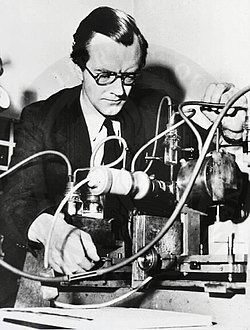Maurice Wilkins Quote
It is essential for genetic material to be able to make exact copies of itself; otherwise growth would produce disorder, life could not originate, and favourable forms would not be perpetuated by natural selection.
Maurice Wilkins
It is essential for genetic material to be able to make exact copies of itself; otherwise growth would produce disorder, life could not originate, and favourable forms would not be perpetuated by natural selection.
Related Quotes
The beauty in the genome is of course that it's so small. The human genome is only on the order of a gigabyte of data...which is a tiny little database. If you take the entire living biosphere, that's...
Freeman Dyson
Tags:
animals, biodiversity, biology, biosphere, data, dna, dna sequencing, genome, information, nature
Even if we have a reliable criterion for detecting design, and even if that criterion tells us that biological systems are designed, it seems that determining a biological system to be designed is aki...
William A. Dembski
Tags:
appendix, biology, coccyx, darwinism, dna, evolution, human appendix, human coccyx, id, intelligent design
Even if we have a reliable criterion for detecting design, and even if that criterion tells us that biological systems are designed, it seems that determining a biological system to be designed is aki...
William A. Dembski
Tags:
biology, coccyx, darwinism, dna, evolution, human appendix, human coccyx, id, intelligent design, junk dna
About Maurice Wilkins
Maurice Hugh Frederick Wilkins (15 December 1916 – 5 October 2004) was a New Zealand-born British biophysicist and Nobel laureate whose research spanned multiple areas of physics and biophysics, contributing to the scientific understanding of phosphorescence, isotope separation, optical microscopy, and X-ray diffraction. He is most noted for initiating and leading early X-ray diffraction studies on DNA at King's College London, and for his pivotal role in enabling the discovery of the double helix structure of DNA.
Wilkins began investigating nucleic acids in 1948. By 1950, he and his team had produced some of the first high-quality X-ray diffraction images of DNA fibers. He presented this work in 1951 at a conference in Naples, where it significantly influenced James Watson, prompting Watson to pursue DNA structure research with Francis Crick.
In 1951, Rosalind Franklin joined King’s College and was assigned to the same DNA project, though without a clear delineation of leadership. Tensions developed due to overlapping roles and lack of administrative clarity. During this period, Franklin and graduate student Raymond Gosling captured the high-resolution Photo 51, a diffraction image of B-form DNA. In early 1953, John Randall instructed Gosling to hand it over to Wilkins. Wilkins, in turn, showed it to Watson—without Franklin's consent. This action has been the subject of significant ethical and historiographical debate.
Using insights from Photo 51 and prior data—including Wilkins' own diffraction studies—Watson and Crick constructed their double helix model in March 1953. Wilkins simultaneously continued experimental validation, producing confirmatory diffraction images published in the same issue of Nature.
Wilkins' contributions were not limited to verification. He had led the DNA diffraction research at King’s before Franklin’s arrival, initiated the methods that led to Photo 51, and played a central role in sharing data and coordinating the laboratory’s DNA efforts—roles often underrepresented in historical summaries.
In later years, Wilkins extended his studies to RNA structure and worked on the biological effects of radiation.
He shared the 1962 Nobel Prize for Physiology or Medicine with Watson and Crick, awarded "for their discoveries concerning the molecular structure of nucleic acids and its significance for information transfer in living material". Although Franklin had died in 1958 and was therefore ineligible, Wilkins acknowledged her work in his writings and interviews.
In 2000, King's College London named one of its science buildings the Franklin-Wilkins Building to honor their contributions. Scholarly reassessments in recent decades have increasingly recognized Wilkins’ role as foundational to the DNA discovery effort.
Wilkins began investigating nucleic acids in 1948. By 1950, he and his team had produced some of the first high-quality X-ray diffraction images of DNA fibers. He presented this work in 1951 at a conference in Naples, where it significantly influenced James Watson, prompting Watson to pursue DNA structure research with Francis Crick.
In 1951, Rosalind Franklin joined King’s College and was assigned to the same DNA project, though without a clear delineation of leadership. Tensions developed due to overlapping roles and lack of administrative clarity. During this period, Franklin and graduate student Raymond Gosling captured the high-resolution Photo 51, a diffraction image of B-form DNA. In early 1953, John Randall instructed Gosling to hand it over to Wilkins. Wilkins, in turn, showed it to Watson—without Franklin's consent. This action has been the subject of significant ethical and historiographical debate.
Using insights from Photo 51 and prior data—including Wilkins' own diffraction studies—Watson and Crick constructed their double helix model in March 1953. Wilkins simultaneously continued experimental validation, producing confirmatory diffraction images published in the same issue of Nature.
Wilkins' contributions were not limited to verification. He had led the DNA diffraction research at King’s before Franklin’s arrival, initiated the methods that led to Photo 51, and played a central role in sharing data and coordinating the laboratory’s DNA efforts—roles often underrepresented in historical summaries.
In later years, Wilkins extended his studies to RNA structure and worked on the biological effects of radiation.
He shared the 1962 Nobel Prize for Physiology or Medicine with Watson and Crick, awarded "for their discoveries concerning the molecular structure of nucleic acids and its significance for information transfer in living material". Although Franklin had died in 1958 and was therefore ineligible, Wilkins acknowledged her work in his writings and interviews.
In 2000, King's College London named one of its science buildings the Franklin-Wilkins Building to honor their contributions. Scholarly reassessments in recent decades have increasingly recognized Wilkins’ role as foundational to the DNA discovery effort.
